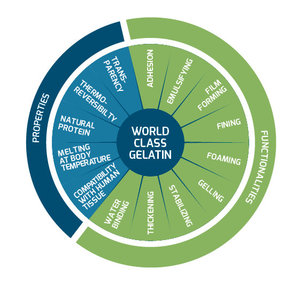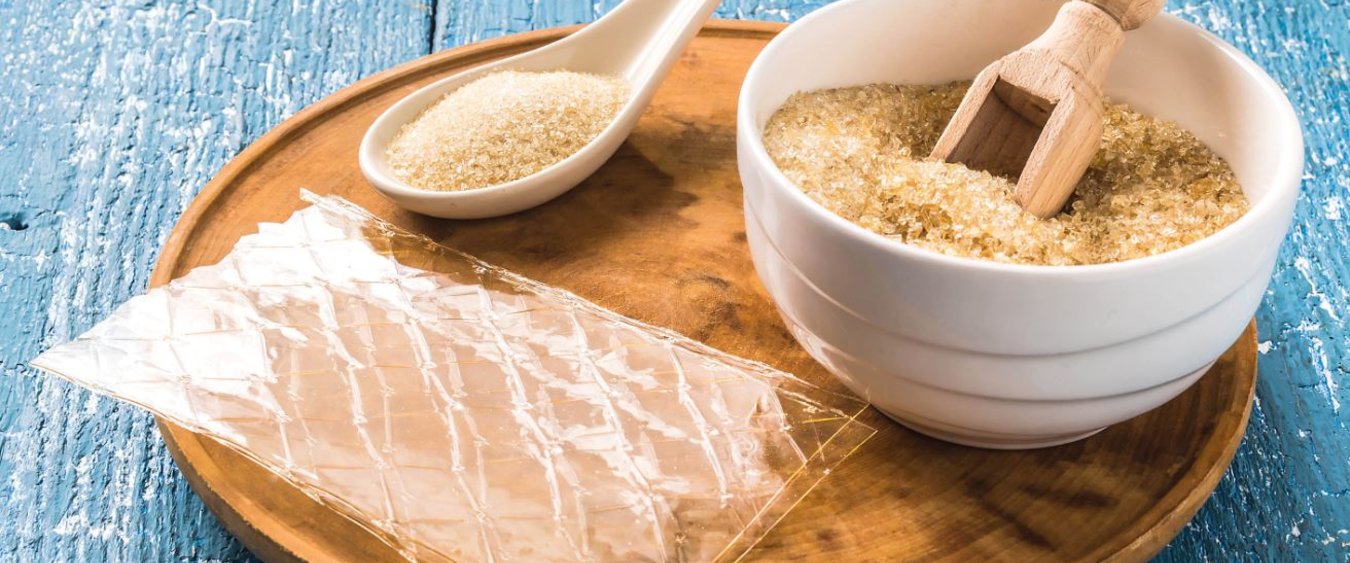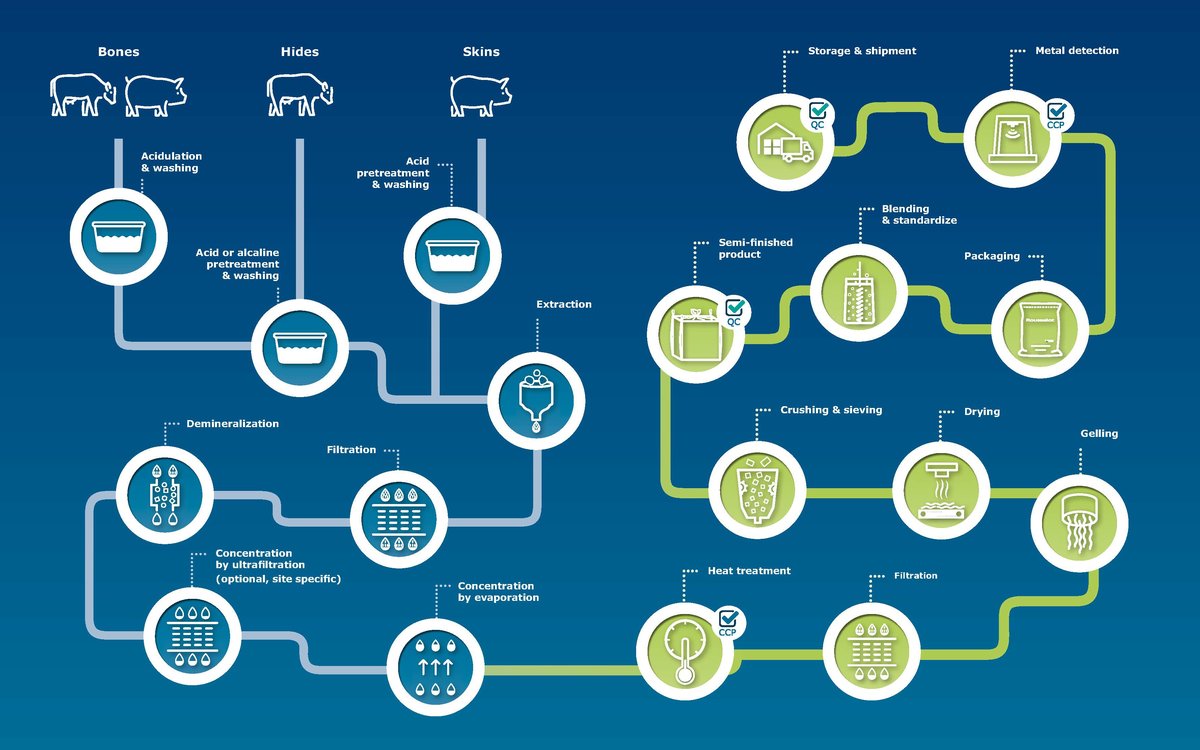What is gelatin?
Put simply, gelatin is a natural protein derived from raw collagen, which is a safe byproduct of the meat industry. It contains eighteen amino acids, some of which are an essential part of a healthy diet.
The versatile ingredient
Because of its unique gelling and thickening functionalities, it is commonly used as an ingredient by food manufacturers and professional chefs. It is also used in home cooking by many people around the world.
As well as being a food ingredient, it’s also used by the pharmaceutical industry in the production of hard and soft capsules for the safe delivery of Active Pharmaceutical Ingredients (APIs).

You probably consume gelatin on a regular basis without realising it
Gelatin is famous for being a key ingredient of water jelly or dessert jelly. It’s what gives the popular dish its “jellyness”. However, if you’re a meat-eater, the chances are that gelatin is pretty integral to your diet without you realizing it.
Whenever you cook meat on the bone or with skin, you are essentially processing collagen into gelatin.
Next time you roast a whole chicken, take a look at the roasting tray after it’s cooled down: you may notice that a jelly has formed with the juices. This is gelatin. Taste it and you might get a lovely burst of savory flavor.
This is because it is great for boosting flavors and melting them deliciously in the mouth (which is one of the reasons why it’s such a popular ingredient in the food industry).
This naturally occurring gelatin forms as a result of the cooking process. When heated up, the raw collagen is broken down and turned into liquid gelatin that jellifies upon cooling. In the industry, this process is known as ‘partial hydrolysis’.
The gelatin you naturally eat is the same as the one used in food products. The only difference is that mass-produced gelatin has gone through a complex and safe extraction process that helps to refine and purify it so it can be a practical ingredient utilized by food manufacturers, chefs and cooks.

Generally, manufactured gelatin comes in two forms, which you may have noticed in your local grocery store:
- Powdered
- Sheet (or leaf)
What is gelatin made from?
It is usually made from pig skins, bovine hides and beef and porcine bones.
This is because they have a high concentration of raw collagen. These raw materials are by-products of the meat industry. If there was no use for these materials, they would be thrown away. So gelatin production helps to prevent wastage and is therefore considered sustainable and a part of the circular economy.
Safe, natural and well-regulated
The manufacturing of gelatin is governed by strict rules that ensure a careful selection of raw materials and their suppliers. All raw materials used in the production undergo strict testing and control to guarantee maximum quality, safety and traceability.
Because it comes from a natural source, gelatin is considered a common foodstuff and not an additive, meaning it doesn’t require an E-number.
Gelatin is also non-GMO, cholesterol-free and non-allergenic, meaning it complies with clean-label standards.
What are the key characteristics of gelatin?
Gelatin is valued for its unique properties and functionalities.
Key Properties:
- It melts at body temperature giving it a wonderful mouthfeel making it ideal for confectionery, such as gummies, marshmallows, chewy candies and many other dairy, meat and dessert products;
- Designed by nature, with low allergenicity, it is fully compatible with the human body and is therefore a perfect excipient and biomaterial for pharmaceutical and medical applications;
- It’s a natural protein that is considered safe, doesn’t require an E-number and is perfect for clean-label products;
- It has thermo-reversibility meaning it can be heated up to a liquid, cooled to a gel, then heated up and cooled again without being damaged;
- It is transparent and flavorless, so it can be used in many combinations of colors and flavors.

Key Gelatin Functionalities:
- Gelling
- Foaming
- Film-forming
- Thickening
- Water-binding
- Emulsifying
- Stabilizing
- Adhesion
- Fining
What is the production process of gelatin?
The production process is extremely safe because:
- all raw ingredients come from animals fit for human consumption and have to meet stringent quality control standards;
- the production environment is hygienic, involves sterilization stages and has to comply with all national and international regulation;
- the gelatin does not undergo any chemical modification and is therefore considered clean-label.
Here is a simple step-by-step outline of the gelatin production process:
Step One: Pre-treatment
The raw material (i.e. beef bones, pork skin etc.) is broken down to small pieces and processed in an acid or alkaline solution. It is then thoroughly rinsed and made ready for the second step.
Step Two: Extraction
The raw material is placed in water (of drinking quality) and heated up. Once all gelatin is in the soluble phase all the solids and fats are removed, leaving a gelatin rich solution.
Step Three: Purification
In order to remove any traces of fat or fine fibers, the solution is then filtered. Standard techniques to remove minerals (such as calcium, sodium, chlorides) are used to create a final purified product.
Step Four: Thickening
The solution is then concentrated into a viscous substance. At this point, it is sterilized under strict hygienic conditions.
Step Five: Drying
The viscous mass is cooled, which solidifies it. The solid gelatin is then pressed through a perforated plate to form ‘jelly noodles’. It is then dried and ground into a fine powder.
As you can see: gelatin undergoes no chemical modification at any stage in the process. This means it is a safe, natural ingredient that can be utilized by the food industry, professional chefs and ordinary consumers alike.


